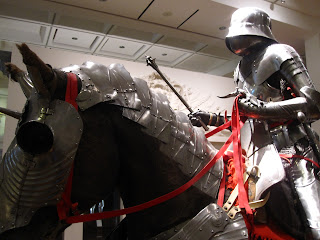The chapter house. Looks old, but the church only became a cathedral in 1914. The room was dedicated in 1939.
Glass above the chapter house entrance which depicts a specific scene from Chaucer's Canterbury Tales. The miller is mentioned to have a meat knife made in Sheffield.
One of the "Six Sheffield Worthies", Lord of the manor William de Lovetot builds the first Norman church on this site in 1101. The foundations are shown on the paper in his hands. The bottom left square is the first link to Sheffield's industry with the monks receiving permission to smelt iron. On the right, Thomas de Furnivall (another Lord of the manor) presents a charter of rights to his tenants.
This is the panel I came to photograph. It shows George Talbot, 4th earl of Shrewsbury, welcoming Cardinal Wolsey as a defacto prisoner to his manor lodge residence. Wolsey spent 18 days at the lodge in constant fear for what Henry had in store for him. At this time, Wolsey also became ill and would only last a few more days before dying at Leicester Abbey. A complete first hand account on Wolsey's stay can be read in The Life Of Wolsey by William Cavendish.
On the bottom right, Mary Queen of Scots sits imprisoned at the manor lodge. More details below!
Remembered here is Mary I granting a charter to the Burgesses of Sheffield in 1554.
Now some close ups...
Keen eyes will spot the Turret House fireplace in the background which bears the arms of the Talbot family. Thus the myth that Mary was actually kept in the Turret house continues!
Mary I enthroned.
For anyone planning to see the interior of Sheffield Cathedral, I am afraid you must wait 14 months as the church is undergoing a massive renovation and expansion. The flooring is being ripped up to replace pipes and the underground heating system. A new entrance room is being built as well which will see the original outer gates placed back in their preliminary position (as evidenced by 19th century prints).
Unfortunately, the floor repair will not attempt to locate the Shrewsbury vault. Not only has its exact entrance been lost, but its contents (or lack thereof) remain a mystery. Burial documents suggest that 16 or 17 coffins were placed in the vault. When it was last opened in 1809, only two were found. Neither belong to the two earls of Shrewsbury who are memorialized above ground. Based on my research, there may be a second vault attached to the first but this was already bricked up by 1809. This second vault would, in fact, lie under the founder's memorial and I suspect that is where we can find George Talbot and the rest of his family. I have contacted the Reverend of the cathedral and he finds the idea quite interesting! Despite archeology lately batting a thousand when it comes to finding dead nobility, I don't think a search will occur anytime soon.



